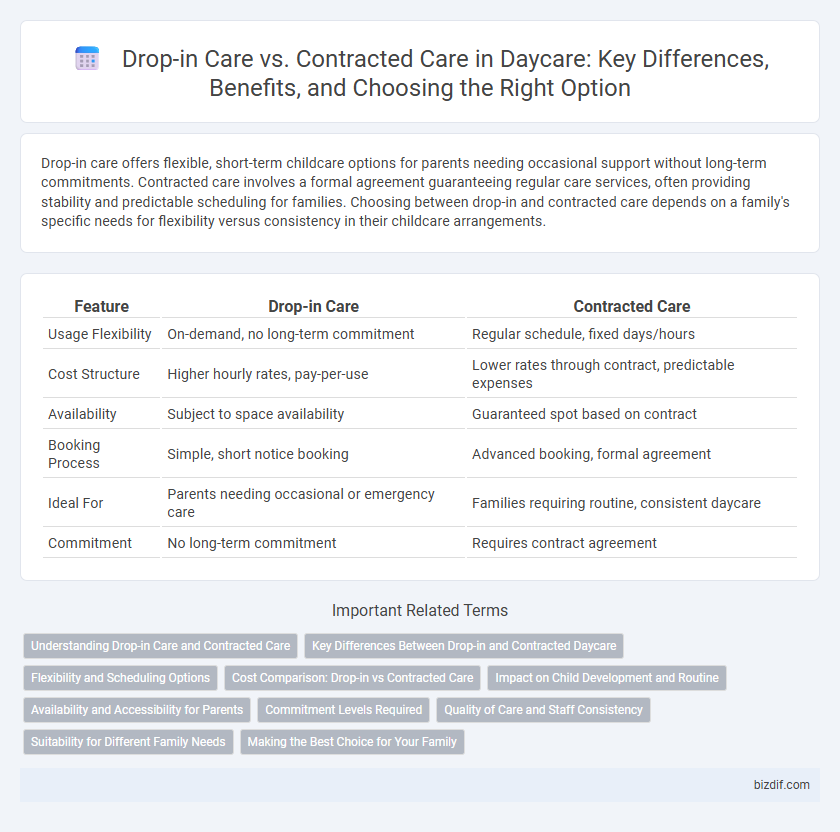Drop-in care offers flexible, short-term childcare options for parents needing occasional support without long-term commitments. Contracted care involves a formal agreement guaranteeing regular care services, often providing stability and predictable scheduling for families. Choosing between drop-in and contracted care depends on a family's specific needs for flexibility versus consistency in their childcare arrangements.
Table of Comparison
| Feature | Drop-in Care | Contracted Care |
|---|---|---|
| Usage Flexibility | On-demand, no long-term commitment | Regular schedule, fixed days/hours |
| Cost Structure | Higher hourly rates, pay-per-use | Lower rates through contract, predictable expenses |
| Availability | Subject to space availability | Guaranteed spot based on contract |
| Booking Process | Simple, short notice booking | Advanced booking, formal agreement |
| Ideal For | Parents needing occasional or emergency care | Families requiring routine, consistent daycare |
| Commitment | No long-term commitment | Requires contract agreement |
Understanding Drop-in Care and Contracted Care
Drop-in care offers flexible, on-demand childcare services without a long-term commitment, ideal for parents needing occasional support. Contracted care involves a formal agreement with set hours and payment terms, ensuring consistent childcare availability for regular schedules. Understanding the differences helps parents choose the best option based on their childcare needs and budget.
Key Differences Between Drop-in and Contracted Daycare
Drop-in care allows parents to use daycare services on an as-needed basis without long-term commitments, offering flexibility but often limited availability and higher hourly rates. Contracted care involves enrolling a child under a fixed schedule with guaranteed spots and consistent care, typically at a lower cost per hour due to the commitment. Key differences include scheduling rigidity, cost structure, and the reliability of care continuity.
Flexibility and Scheduling Options
Drop-in care offers maximum flexibility by allowing parents to schedule childcare on an as-needed basis without long-term commitments, ideal for irregular or unpredictable work hours. Contracted care provides set scheduling options with consistent daily or weekly timetables, ensuring regularity and often lower rates for families requiring stable, ongoing childcare. Choosing between drop-in and contracted care depends on balancing the need for adaptable scheduling against the benefits of routine and cost efficiency.
Cost Comparison: Drop-in vs Contracted Care
Drop-in care typically incurs higher hourly rates due to its flexibility and on-demand availability, often ranging from $10 to $15 per hour depending on location. Contracted care usually offers a lower average cost per hour, with monthly fixed fees or bulk-hour packages reducing the effective hourly rate to around $6 to $10. Families seeking predictable expenses and regular schedules benefit financially from contracted care, while drop-in care suits those needing occasional childcare without long-term commitments.
Impact on Child Development and Routine
Drop-in care offers flexible childcare options that accommodate varying schedules but may disrupt a child's routine, potentially affecting emotional security and cognitive development. Contracted care provides consistent daily schedules and familiar caregivers, fostering stable attachments and predictable environments crucial for language acquisition and social skills development. Predictability in contracted care supports better sleep patterns and behavioral regulation, enhancing overall developmental outcomes.
Availability and Accessibility for Parents
Drop-in care offers flexible availability for parents needing occasional childcare without long-term commitments, making it accessible for unpredictable schedules or emergencies. Contracted care provides guaranteed spots and stable hours, ideal for parents seeking consistent, reliable childcare arrangements. Accessibility varies as drop-in care depends on daily space availability, while contracted care ensures priority enrollment but requires advanced booking.
Commitment Levels Required
Drop-in care offers flexible, on-demand childcare without long-term commitment, ideal for parents requiring occasional assistance. Contracted care requires a formal agreement, securing consistent daily or weekly attendance and ensuring priority access and predictable scheduling. Understanding these commitment levels helps families choose between convenience and stability based on their childcare needs.
Quality of Care and Staff Consistency
Drop-in care offers flexible access to childcare but may lead to variable quality due to fluctuating staff availability and less consistent caregiver-child relationships. Contracted care provides higher quality through established routines and dedicated staff, promoting stable interactions that support child development and emotional security. Consistent staffing in contracted care ensures personalized attention and stronger trust, critical factors for optimal early childhood care outcomes.
Suitability for Different Family Needs
Drop-in care offers flexible, short-term childcare ideal for families with unpredictable schedules or occasional care needs. Contracted care provides consistent, long-term arrangements better suited for families requiring reliable daily support and structured routines. Choosing between them depends on a family's unique time commitments, budget, and preference for flexibility versus stability.
Making the Best Choice for Your Family
Drop-in care offers flexible, short-term child care without long-term commitments, ideal for families with unpredictable schedules or occasional needs. Contracted care provides consistent, scheduled child care with stable rates and guaranteed availability, benefiting families requiring regular support. Evaluating your family's routine, budget, and care preferences ensures selecting the best option for your child's well-being and development.
Drop-in care vs Contracted care Infographic

 bizdif.com
bizdif.com